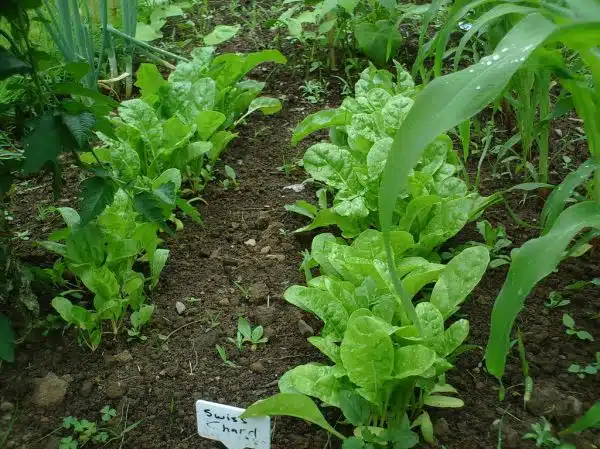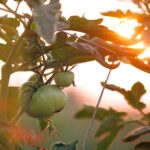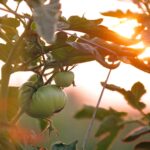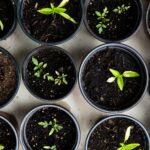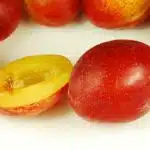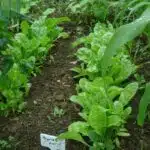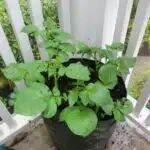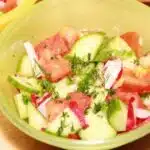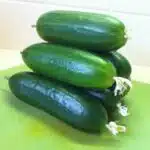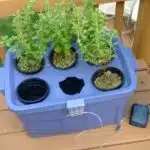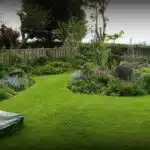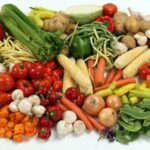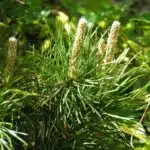As a vegetable gardening expert, I have experimented with various containers for growing vegetables over the years. The right container can not only provide an ideal environment for your plants to grow, but it can also add aesthetic appeal to your garden. With so many options available in the market, choosing the right container can be overwhelming. In this article, I will introduce you to six great containers for growing vegetables that are both practical and visually appealing.
Container gardening has become increasingly popular in recent years as it offers a solution for those who have limited space or lack access to a traditional garden. A well-designed container can provide ample space for plants to grow while allowing you to control soil quality and moisture levels easily. Whether you are planting herbs, tomatoes or peppers, choosing the right container is crucial to ensure a successful harvest. In this article, I will explore six different types of containers that will help you maximize your vegetable yield while adding charm and personality to your garden.
Benefits Of Container Gardening
According to recent studies, container gardening has become increasingly popular among urban dwellers. In fact, over 35% of households in cities across the world have adopted this form of gardening due to its numerous benefits. Container gardening is an excellent way to grow vegetables for those who do not have access to a traditional garden or yard. Additionally, it is a fantastic alternative for people who struggle with mobility issues since containers can be placed at various heights.
One of the primary benefits of container gardening is that it allows you to control the growing environment. With container gardening, you can regulate soil quality, water and nutrient intake more efficiently than in traditional gardens. This makes it easier to maintain ideal conditions for your plants’ growth throughout their lifecycle. Container gardens are also less susceptible to pests and diseases because they are elevated off the ground.
Tips for successful container gardening include selecting the right size pot for your plant’s growth stage, ensuring adequate drainage, and using high-quality soil mixtures. It is also essential to consider the type of vegetables you want to grow and their preferred growing conditions when choosing a container. For example, some vegetables require deeper pots than others due to their root systems’ length. Ultimately, with proper preparation and attention, anyone can enjoy a thriving vegetable garden in containers regardless of space limitations or other challenges they face.
As we move forward into discussing factors to consider when choosing a container, keep in mind that there are many types of containers available on the market today. From clay pots and plastic crates to wooden barrels and hanging baskets- each option has its advantages and disadvantages depending on what you want out of your garden!
Factors To Consider When Choosing A Container
When selecting a container for growing vegetables, size is a key factor to consider. The container should be large enough to accommodate the root system of the vegetable plants and must provide adequate drainage. Material is also important and can range from terracotta pots to plastic containers. Location, sunlight and temperature should also be considered since these environmental factors can influence the success of the vegetable plants.
Size
Choosing the ideal size for a container is crucial in container gardening. As a vegetable gardening expert, I recommend selecting containers that are big enough to accommodate the best vegetables you intend to grow. However, it’s important to keep in mind that the bigger the container, the more soil it will require and subsequently, more effort and cost in maintaining it.
You must also consider the space where you’ll place your containers before deciding on their ideal size. If you have limited space on your patio or balcony, it may be best to choose smaller containers that can fit comfortably without compromising on plant growth. On the other hand, if you have ample space in your garden or backyard, larger-sized containers would be more suitable for growing vegetables such as tomatoes and cucumbers.
When selecting a container size for vegetable gardening, you should also consider the type of vegetable plant you want to cultivate. Different plants have varying root depths and require specific amounts of soil and nutrients. For example, shallow-rooted plants like lettuce and herbs require shallower containers while plants with deep roots like carrots and potatoes need deeper containers. It’s essential to research each plant’s unique requirements before selecting an appropriate sized container.
In conclusion, when choosing a container for vegetable gardening, size is a critical factor that should not be overlooked. Assessing available space and considering each plant’s needs are essential steps in determining an ideal-sized pot/container. By following these guidelines, gardeners can achieve optimal results while minimizing effort and cost in maintaining their gardens throughout the season.
Drainage
Design ideas and plant selection are crucial when deciding to start a vegetable garden. However, choosing the right container size is equally important. Another factor that must be considered is drainage.
Drainage is critical in container gardening as it affects the plants’ health and growth. A lack of proper drainage can lead to waterlogging, which can cause root rot and ultimately kill the plant. Therefore, it’s important to select a container with adequate drainage holes at the bottom.
Additionally, gardeners must ensure that their chosen pot has a saucer or tray to collect excess water. This helps prevent water from pooling around the roots and promotes healthy soil moisture levels. By considering design ideas, plant selection, and drainage needs, gardeners can create an optimal environment for their vegetables to thrive.
Choosing The Right Size Container For Your Plants
When it comes to vegetable gardening, the size of your container can make a significant difference in the health and yield of your plants. Choosing the right size container is crucial, as too small a container will restrict root growth and stunt plant development, whereas too large a container can lead to overwatering and waterlogging. Therefore, it is essential to consider factors such as the type of vegetable you want to grow, its mature size, and the available space before selecting a container.
Another critical factor to consider when choosing a container for your vegetables is the material it is made of. The most commonly used materials are plastic, ceramic or clay pots, metal containers like galvanized steel or copper, wooden crates or barrels. Each material has its pros and cons that must be taken into account before making a decision. For example, while plastic containers are lightweight and cheap compared to other options, they may not be durable enough for long-term use.
Drainage considerations are also vital when selecting containers for your veggies. Proper drainage ensures that excess water drains away from the roots of your plants instead of sitting in the soil and causing root rot or fungal infections that can kill your crops. It is best to choose containers with drainage holes at their base or drill holes yourself if necessary. Additionally, using rocks or gravel at the bottom of your pots can improve drainage by creating an air gap between soil and water.
- A well-draining soil mix with organic matter like compost or peat moss.
- Regular watering schedule based on individual plant needs.
- Fertilizer application at regular intervals throughout the growing season.
- Mulching around plants helps retain moisture in hot weather while suppressing weeds.
Plastic containers: pros and cons
Plastic containers are some of the most popular choices for vegetable gardening due to their affordability and portability. They come in various sizes and shapes suitable for different types of vegetables such as tomatoes, peppers, lettuce etc., but they also have their downsides. One of the cons of plastic containers is that they are not as sturdy as other materials like ceramic or metal, and they may crack or break over time. Additionally, plastic can degrade under prolonged exposure to sunlight leading to fading or discoloration. However, some new varieties come with UV inhibitors that can resist sun damage for extended periods.
Plastic Containers: Pros And Cons
As a vegetable gardening expert, I have seen many people opt for plastic containers as they are convenient and widely available. However, these containers come with both pros and cons. To illustrate this point, think of plastic containers as the fast food of the gardening world. Just like fast food, it is quick and easy to obtain but not always the best option for our health in the long run.
On one hand, plastic containers are lightweight and can be easily moved around which makes them an excellent choice for those with limited space or mobility issues. They are also affordable and come in various sizes which means you can customize your garden according to your needs. However, there are also some downsides to using plastic containers. Firstly, they are not environmentally friendly as they take hundreds of years to decompose in landfills. Secondly, the chemicals used in producing plastic can leach into the soil over time which could affect the growth of your plants.
Recyclable alternatives such as biodegradable pots made from coconut coir or rice husks are becoming increasingly popular among environmentally conscious gardeners. These pots break down quickly without releasing harmful chemicals into the soil. However, they may not be as durable as plastic containers and may need to be replaced more often. If you do decide to use plastic containers in your garden, make sure you choose high-quality ones that will last longer and avoid buying single-use plastics whenever possible to reduce their environmental impact.
Next up we’ll take a look at wooden containers: pros and cons. Wooden containers offer a natural aesthetic that blends well with any garden setting while being eco-friendly at the same time.
Wooden Containers: Pros And Cons
Wooden containers are a popular choice for vegetable gardening enthusiasts due to their natural and rustic appearance. However, like any gardening container, wooden planters come with advantages and disadvantages that should be considered before making a purchase.
Advantages of wooden containers include their affordability, versatility, and ability to blend in with outdoor surroundings. Wooden planters can be customized to fit any size or shape needed, making them ideal for small or irregularly shaped spaces. Additionally, wood is a natural insulator which helps regulate soil temperature and moisture levels.
On the other hand, there are also some disadvantages of using wooden containers for vegetable gardening. One major drawback is that they require more maintenance than other types of planters due to their susceptibility to rotting and pests such as termites. Furthermore, certain types of wood such as cedar or redwood can be expensive and not readily available in all areas.
When it comes to choosing the right wooden container design for vegetable gardening, there are several options to consider. Here are the top four designs:
- Raised garden beds – These elevated wooden planters provide better drainage and reduce back strain while working in the garden.
- Tiered planter boxes – Ideal for small spaces or apartment balconies, tiered planters allow you to grow multiple plants in one container.
- Half barrels – These large wooden containers provide ample space for growing vegetables such as tomatoes or peppers.
- Window boxes – Perfect for herbs or lettuce greens, window boxes offer a compact and convenient way to grow fresh produce.
Transitioning into the subsequent section about ceramic containers: pros and cons, it’s important to consider all options when selecting a container for your vegetable garden as each type has its unique benefits and drawbacks.
Ceramic Containers: Pros And Cons
Wooden containers have their own set of advantages and disadvantages when it comes to growing vegetables in them. But if you’re looking for a material that offers better insulation and aesthetics, then ceramic containers might be worth considering. Ceramic containers come in various sizes, designs, and colors, making them versatile and attractive additions to any garden or patio.
One of the biggest advantages of using ceramic containers is their ability to retain moisture, which can be beneficial for plants that require consistent watering. However, this same feature can also be a disadvantage since overwatering can lead to root rot or other fungal diseases. Additionally, ceramic containers tend to be heavier than other materials, making it difficult to move them once they are filled with soil and plants.
Despite its limitations, there are several types of vegetables that thrive in ceramic containers. These include herbs like basil and parsley; leafy greens such as lettuce and spinach; and small fruits like strawberries. It’s important to note that ceramic containers may not be suitable for larger plants with extensive root systems such as tomatoes or cucumbers.
| Advantages | Disadvantages | Best Plants to Grow |
|---|---|---|
| Retains moisture well | Heavy weight | Herbs (basil, parsley) |
| Aesthetically pleasing | Prone to overwatering | Leafy greens (lettuce, spinach) |
| Durable material | Can break easily if dropped | Small fruits (strawberries) |
Next up are metal containers: pros and cons. While metal containers offer their own unique benefits for growing vegetables, they also come with a few drawbacks that should be considered before choosing this material for your garden needs.
Metal Containers: Pros And Cons
Metal containers are a popular choice for growing vegetables due to their durability and aesthetic appeal. However, there are both pros and cons to using metal containers in your vegetable garden. One of the main advantages of metal containers is their versatility in terms of size and shape, making them suitable for a variety of plants. Additionally, metal containers are typically easy to move around your garden, allowing you to adjust the amount of sunlight your plants receive throughout the day.
On the other hand, there are some downsides to using metal containers for vegetable gardening. One concern is that they can get hot in direct sunlight, potentially damaging plant roots or causing soil to dry out too quickly. To combat this issue, consider decorating metal containers with light-colored paint or covering them with shade cloth during the hottest parts of the day. Another issue is rust prevention in metal containers, as rust can be harmful to both plants and soil. To avoid this problem, choose high-quality metal containers that are resistant to rust or apply a sealant before planting.
Overall, using metal containers for vegetable gardening has its pros and cons. They offer versatility and durability but require extra attention to prevent overheating and rusting issues. By taking steps such as decorating with light-colored paint or applying sealant before planting, you can enjoy the benefits of these containers while avoiding potential problems down the line. In the next section, we will discuss raised beds: their advantages and disadvantages for growing vegetables.
Raised Beds: Pros And Cons
Raised beds offer numerous advantages to vegetable gardeners, such as improved soil drainage, fewer weeds, and increased productivity as plants can be planted closer together. However, raised beds can also be expensive to construct, require more frequent watering, and can be difficult to reach for gardeners with limited mobility. Additionally, there are numerous types of containers that can be used for raised bed gardening, including wooden planters, galvanized steel containers, and plastic bins. Ultimately, the type of container chosen will depend upon the needs of the individual gardener.
Raised Beds Pros
Raised beds are an excellent option for vegetable gardening as they provide several benefits. Firstly, raised beds offer better soil drainage, which reduces the risk of waterlogged soil and root rot. Secondly, they provide an opportunity to create a customised growing environment by choosing the best materials for raised beds that suit specific crops and gardening conditions. For instance, raised beds made from cedar or redwood are ideal for vegetables as they are resistant to rot and pests.
Furthermore, raised beds allow gardeners to control the quality of their soil. By adding nutrient-rich organic matter such as compost, manure or peat moss, gardeners can improve the health of their soil and consequently achieve better yields. Raised beds also make it easier to manage weeds as they restrict weed growth around plants while providing easy access for weeding.
When building a raised bed, it is crucial to choose the right materials that will ensure durability and longevity. The best materials for raised beds are those that are untreated and free from harmful chemicals such as arsenic or lead. Some of the most popular materials include cedar, redwood, cypress and composite lumber made from recycled plastic. Raised beds made from concrete blocks or bricks may also be used if they are stacked correctly and reinforced with steel bars.
In conclusion, using raised beds in vegetable gardening offers numerous benefits ranging from improved drainage to better control over soil quality. By selecting the right materials for constructing a raised bed, gardeners can create a customised growing environment that meets their specific needs while ensuring longevity and durability for years to come.
Raised Beds Cons
While raised beds have numerous benefits for vegetable gardening, it is also important to consider the potential drawbacks. One of the main concerns when using raised beds is the cost of materials and construction. Depending on the size and materials used, building a raised bed can be relatively expensive compared to traditional in-ground gardening methods.
Another drawback of using raised beds is their limited growing space. Since plants must be contained within the borders of the bed, there may not be enough room to grow certain crops such as sprawling vines or large bushes. Additionally, some gardeners may find it difficult to access plants in the center of a raised bed without stepping onto the soil, which can cause compaction and hinder plant growth.
Alternative options to raised beds include container gardening or traditional in-ground gardening. Container gardening involves planting vegetables in pots or other containers that can be moved around as needed. This method provides flexibility and can be ideal for those with limited space or who want to grow plants indoors. Traditional in-ground gardening involves planting directly into the soil without any additional borders or containers. While this method requires more upkeep and may not offer as much control over soil quality, it is a cost-effective option that allows for greater growing space and versatility.
In summary, while there are several benefits to using raised beds for vegetable gardening, it is important to consider alternative options and potential drawbacks before committing to this method. By weighing the pros and cons of each approach and considering individual needs and preferences, gardeners can choose the best option for their specific situation.
Hanging Baskets: Pros And Cons
Hanging baskets are a popular option for those interested in growing vegetables but have limited space. They can be hung on porches, balconies, or in small gardens to add a decorative touch while also providing fresh produce. However, there are both pros and cons to using hanging baskets for vegetable gardening.
Firstly, one of the biggest advantages of using hanging baskets is their decorative options. With a wide variety of basket designs available, gardeners can choose from different colors, textures, and materials to match their personal style. Additionally, since they are elevated off the ground, they can also serve as a way to keep pests away from the plants.
However, there are also some maintenance tips that should be considered when using hanging baskets. Since they are suspended in the air, they will require regular watering to prevent the soil from drying out. Furthermore, proper drainage is crucial for preventing waterlogged soil which can lead to root rot. Gardeners should also be mindful of the weight of their baskets and ensure they are securely anchored to prevent accidents.
- The lush greenery cascading over the edge of a hanging basket creates an inviting atmosphere.
- Imagine having fresh herbs at your fingertips without ever leaving your porch.
- A bountiful harvest can be achieved with just a few carefully placed hanging baskets.
- Hanging baskets provide an excellent opportunity for children to learn about gardening and where their food comes from.
- A well-maintained hanging basket not only provides fresh produce but adds value to any space.
In summary, while there are maintenance considerations when it comes to using hanging baskets for vegetable gardening, their decorative options make them an attractive option for those with limited space who still want fresh produce readily available. With proper care and attention given to watering and drainage needs, gardeners can create beautiful and functional displays with their hanging baskets.
As we move forward into discussing vertical gardens: pros and cons, it is important to consider how they compare and contrast with hanging baskets.
Vertical Gardens: Pros And Cons
Did you know that vertical gardens can grow up to 20 times more plants per square foot than traditional gardening methods? That’s a staggering statistic that highlights the potential of vertical gardening. However, like any other form of gardening, it has its pros and cons.
One of the biggest advantages of vertical gardens is their ability to maximize space. This is particularly useful for urban gardeners who have limited outdoor space but still want to grow fresh produce. Vertical gardens also offer a wide range of options when it comes to types of plants that can be grown. Some popular choices include herbs, lettuce, strawberries, and tomatoes.
On the other hand, vertical gardens require careful planning and maintenance. The soil in these containers tends to dry out faster than traditional garden beds, which means they need regular watering. Additionally, the types of plants suitable for vertical gardens are limited by their size and weight. It’s important to choose plants that won’t overload or damage the structure supporting them.
In summary, vertical gardens offer an excellent solution for maximizing space while growing a variety of plants. However, they require careful planning and maintenance to ensure optimal growth conditions. When selecting types of plants for vertical gardens, it’s important to consider their size and weight limitations so as not to damage the structure supporting them. In the next section, we’ll explore self-watering containers: pros and cons.
Self-Watering Containers: Pros And Cons
Self-watering containers are becoming increasingly popular among vegetable gardeners as they can help reduce the amount of time spent on maintenance. However, it is important to consider both the advantages and disadvantages of such containers prior to making a purchase. On the positive side, self-watering containers can provide consistent moisture levels to plants, reduce the risk of overwatering and allow gardeners to go on vacation without worrying about their plants. Conversely, self-watering containers may require more initial investment, need regular maintenance, and can be difficult to move once in place.
Pros
Self-watering containers have become increasingly popular among vegetable gardeners due to their numerous advantages. These containers are designed with a built-in reservoir that stores water, allowing plants to draw moisture as needed. One of the benefits of self-watering containers is that they provide a consistent supply of moisture to plants, preventing them from over or under watering. This ensures that plants grow healthily and produce a bountiful harvest.
Another advantage of self-watering containers is that they reduce the amount of time and effort required for watering plants. Unlike traditional containers that require frequent watering, self-watering containers can go several days without being refilled. This makes them an ideal option for individuals with busy schedules who may not have the time to water their plants regularly. Additionally, self-watering containers are also beneficial for those who live in areas with limited access to water resources.
Moreover, self-watering containers offer great flexibility when it comes to placement options. These containers can be placed on patios, balconies or even indoors, making them suitable for individuals who do not have access to large gardening spaces. They are also available in different sizes and styles, providing gardeners with a wide range of options to choose from depending on their needs and preferences. Overall, the benefits of self-watering containers make them an excellent choice for growing vegetables and other plants in any setting.
Cons
While self-watering containers offer numerous benefits, there are also some potential downsides to consider. As with any gardening method, container gardening comes with its own set of challenges, and self-watering containers are no exception. One of the main disadvantages of self-watering containers is their cost. These containers can be more expensive than traditional planting pots due to their added features and materials.
Another potential con of self-watering containers is that they may not be suitable for all types of plants. While these containers work well for vegetables that do not require deep soil, such as herbs or lettuce, they may not provide enough space for larger plants with extensive root systems. Additionally, some gardeners may find that they need to supplement the water supply in self-watering containers during hot weather or drought conditions.
Finally, while self-watering containers can save time when it comes to watering plants, they still require regular maintenance to ensure proper functioning. Gardeners must regularly monitor the water level in the reservoir and adjust it as needed to prevent over or under watering. Additionally, these containers should be cleaned periodically to prevent the buildup of algae or other contaminants.
In conclusion, while there are certainly some cons associated with using self-watering containers for vegetable gardening, many gardeners find that the benefits outweigh any potential challenges. By carefully selecting appropriate plants and properly maintaining the container, gardeners can enjoy a bountiful harvest without the hassle of constant watering and upkeep.
Diy Container Ideas
Self-watering containers can be a great option for vegetable gardeners, but there are also some drawbacks to consider. For those who prefer a more hands-on approach to gardening, DIY container modifications can be an exciting alternative. With some creativity and ingenuity, repurposed containers can become unique vessels for growing vegetables.
One popular DIY container idea is to use old wooden pallets as the base for a vertical garden. By standing them upright and placing soil-filled planters in the openings, you can create a compact and visually appealing garden that takes up minimal space. Other repurposed container ideas include using old tires or even plastic bottles to create unique planters.
When it comes to maintaining healthy plants in containers, there are several tips to keep in mind. First, make sure your container has adequate drainage holes so that excess water can escape. Additionally, choose the right soil for your plants and fertilize regularly to keep them healthy and thriving. Finally, be mindful of pests and diseases that may affect your plants and take action promptly if needed.
Transition: Now that we’ve explored some creative DIY container ideas, let’s dive into some tips for maintaining healthy plants in these containers.
Tips For Maintaining Healthy Plants In Containers
- Container gardening is a great way to grow vegetables in limited space, but it requires more careful attention to maintain healthy plants.
- Adequate watering is essential for container plants, as they can quickly dry out in the summer heat and need to be monitored daily.
- Soil selection is important for successful container gardening, as it needs to be lightweight and well draining to prevent root rot.
- Good drainage is essential for healthy container plants, as excess water must be able to escape for air to reach the root system.
- Light requirements for container plants need to be taken into account when choosing a location, as most vegetables need at least six hours of direct sunlight each day.
- Fertilizers tailored for container plants, as well as regular pest control, are necessary to maintain healthy growth and discourage disease.
Watering
Proper watering is one of the most important aspects of maintaining healthy plants in containers. Watering frequency largely depends on the type of plant, the size of container, and the environmental conditions. In general, container plants need to be watered more frequently than those grown in the ground. It is crucial to avoid overwatering as it can cause root rot and other fungal diseases.
One effective way to ensure proper watering is by using drip irrigation. This system delivers water directly to the base of each plant, reducing evaporation and waste. Drip irrigation also minimizes soil compaction and erosion that can occur with traditional watering methods such as overhead sprinklers. Moreover, it saves time and effort as it requires less frequent attention.
In conclusion, maintaining healthy plants in containers requires proper watering techniques. Watering frequency should be adjusted based on plant needs and environmental factors while avoiding overwatering. Implementing a drip irrigation system not only conserves water but also promotes healthier plant growth resulting in higher yields for vegetable gardeners.
Soil Selection
Maintaining healthy plants in containers requires more than just proper watering techniques. Soil selection plays a crucial role in plant growth and development. One important factor to consider is the pH level of the soil. Different plants thrive in different pH levels, so it is important to choose soil that matches the specific needs of the plant. For example, vegetables like tomatoes prefer slightly acidic soil with a pH level between 6.0-6.8, while blueberries require a more acidic soil with a pH level between 4.5-5.5.
Another factor to consider when selecting soil for container gardening is whether to use organic or inorganic options. Organic soils are made from natural materials such as compost and peat moss and contain beneficial microorganisms that promote healthy plant growth. They also tend to be more sustainable and environmentally friendly than their synthetic counterparts. Inorganic soils, on the other hand, are made from synthetic materials such as perlite and vermiculite and are often more consistent in texture and nutrient content.
Ultimately, choosing the right soil for container gardening can make all the difference in producing healthy plants that thrive throughout the growing season. It is important to take into account both pH levels and organic vs. inorganic options when making this decision. By doing so, vegetable gardeners can ensure they are providing their plants with optimal conditions for growth, resulting in bountiful harvests of fresh produce for themselves or those they serve.
Drainage
Maintaining healthy plants in containers requires more than just soil selection and proper watering techniques. Another crucial factor that vegetable gardeners should consider is the importance of proper drainage. Without adequate drainage, excess water can cause the roots to rot, leading to stunted growth or even plant death.
To improve drainage in containers, gardeners can take a few simple steps. First, they should choose pots with drainage holes at the bottom to allow excess water to flow out. Second, it is essential to use well-draining soil that allows water to pass through easily. Gardeners can add sand, perlite or vermiculite to their soil mixtures for improved drainage. Lastly, one must avoid placing saucers under the pots as this will prevent the excess water from draining out.
Proper drainage is critical for maintaining healthy plants in containers as it helps prevent root rot and other issues caused by overwatering. By choosing pots with drainage holes and using well-draining soil mixes, vegetable gardeners can help ensure optimal growing conditions for their plants and enjoy bountiful harvests throughout the growing season.
Choosing The Right Soil Mix For Your Container
An important factor to consider when growing vegetables in containers is the soil mix. According to a survey conducted by the National Gardening Association, 85 percent of container gardeners use some type of organic soil mix. Organic soil refers to a mixture of natural materials like compost, peat moss, and perlite or vermiculite. This type of soil provides good drainage and allows roots to breathe.
To ensure successful growth, it is crucial to choose the right soil amendments for your vegetable plants. Soil amendments are added nutrients that improve the quality of the soil and provide essential minerals for plant growth. Some examples of popular soil amendments include bone meal, blood meal, and fish emulsion. These can be found at most gardening stores or online retailers.
When selecting a soil mix and amendments for your container garden, keep in mind the specific needs of your plants. For example, tomatoes require more calcium than other vegetables, so adding crushed eggshells or gypsum to the soil mix can help prevent blossom end rot. Onions benefit from sulfur-rich amendments like Epsom salt. Be sure to research each vegetable’s specific requirements before planting to ensure optimal growth.
Now that you have selected the best organic soil mix and amendments for your container garden, it’s time to move on to choosing the best vegetables for container gardening.
Best Vegetables For Container Gardening
When it comes to container gardening, selecting the right vegetables is crucial for a bountiful harvest. The best vegetables for container gardening are those that do not require too much space, have shallow roots, and can tolerate different soil types. Some examples include tomatoes, peppers, lettuce, radishes, carrots, and herbs such as basil and parsley.
To maximize yields in container gardening, there are a few tips to keep in mind. First, choose the right size container for your specific vegetable. Larger plants like tomatoes and peppers need bigger containers than smaller plants like lettuce or herbs. Second, use high-quality potting soil with enough organic matter to retain moisture and nutrients. Third, make sure your containers have good drainage holes to prevent waterlogging and root rot.
Overall, container gardening is an excellent way to grow fresh vegetables at home even if you don’t have a large garden space. By choosing the best vegetables for container gardening and following some simple tips for maximizing yields, you can enjoy a successful harvest of fresh produce all season long.
Conclusion
Container gardening is a fantastic way to grow vegetables in small spaces, and it offers many benefits. However, choosing the right container can be overwhelming. There are several factors to consider, such as size, material, and drainage. Plastic containers are durable but may not provide enough insulation for plants. Wooden containers have a rustic charm but require more maintenance. DIY containers offer endless possibilities but may not be suitable for all plants.
When choosing a container, it is essential to consider the needs of your plants and the conditions in which they will grow best. For example, tomatoes require larger containers with deep soil, while lettuce thrives in shallow containers with well-draining soil. Choosing the right soil mix is also crucial for healthy plant growth.
Despite the challenges of container gardening, there are many options available that can make it an enjoyable and rewarding experience. Whether you choose plastic or wooden containers or opt for a DIY project, there are many great ways to grow vegetables in small spaces. So go ahead and get creative with your container choices – just remember to keep your plant’s needs in mind!
Image Credits
- “Vegetable Garden Growing” by James P. Mann (featured)

